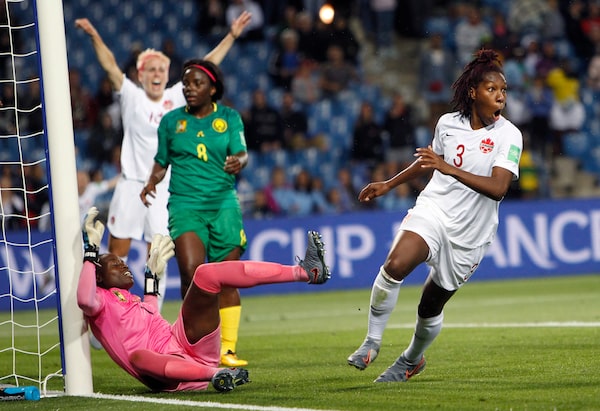
The win over Cameroon was a vital step, but one that should make supporters nervous.Claude Paris/The Associated Press
There are several stories that emerge from Canada’s first game at this World Cup. The main one is a 1-0 victory: A hard-fought one over a resilient, intense Cameroon on Monday evening in France. A vital step, but one that should make supporters nervous. The goals don’t come easily to this team.
Another story is Sincy. The glorious, indefatigable Christine Sinclair. Go ahead, call her Sincy. Everybody does and she doesn’t mind. There she stands, on the cusp of surpassing the career goal-scoring record in men’s and women’s international soccer. Going into Monday’s game, Sinclair was three short of the record of 184 goals held by former U.S. World Cup winner Abby Wambach. The 35-year-old Sinclair is playing in her fifth tournament and scored 181 goals in 281 senior appearances.
In the closing minutes of this raw, physical encounter she came close again and again. She didn’t score. There’s disappointment in the air about that, and there should be nervousness that she’s still so relied upon.
These days Sinclair plays deep. She is not the focus of Canada’s attack. She simply doesn’t have the speed to sprint forward constantly and terrorize defenders with her superfast reaction. Set pieces are her wheelhouse and she prowls rather than speeding in toward the opponents’ goal. It’s up to others to get the goals.
Canada played a conventional 4-4-2 formation: keeper Stephanie Labbé; Ashley Lawrence, Kadeisha Buchanan, Shelina Zadorsky, Allysha Chapman; Nichelle Prince, Desiree Scott, Sophie Schmidt, Janine Beckie; Sinclair and Jessie Fleming. But it never quite looked like just two at the front. It was an attacking midfield all game and, eventually it worked.
Less than two minutes in, it was all bustle from Canada and tussle from Cameroon. Two corners and a free kick near the Cameroon goal gave Canada chances that came to nothing and mostly gave evidence that Cameroon was here to tackle hard and intimidate. The same ragged, but often thrilling pattern continued for ages – Canada attacking down the middle, or speeding down the wings, being crowded off the ball and Cameroon looking for a quick counterattack.
Beckie was key for Canada, playing clever one-two balls with Fleming on the edge of the Cameroon penalty area. This was a confident, cutting Canadian team, dominating possession and alert for those counterattacks. Chapman was as vital at the back as Beckie was at the front, tireless in chasing down the ball before the lone Cameroon attacker had much from it. Labbé was untroubled. She could have knitted a sweater for all her hands were needed.
Prince came close near the end of the first half. Then it happened, off yet another Canadian corner. Buchanan as always came forward and with a late run connected well to head the ball into the Cameroon goal. At last, after almost 70-per-cent possession by Canada.
Cameroon clearly felt it was possible to gain points from the game, even as Canada’s torrid attacking pace continued at the start of the second half. A double substitution gave the team an oomph. In truth, Canada’s collective effort was looking exhausted at that point.
Claudine Meffometou almost had a replay of Buchanan’s goal in the 70th but her header off a corner was just wide. It was easily Cameroon’s best chance, but the core of the story was Canada’s failure to wrest more goals from all that attack and possession.
There is a lot to savour here. A lot to admire about this version of Canada’s women’s team. Canada’s hosting of the Women’s World Cup in 2015 came at the wrong time for the national team. It was a team of veterans and their true collective strength was unknowable, since they automatically qualified as hosts. They were quarter-finalists on home soil in 2015, they won bronze at the Olympics a year later and going into the tournament in France they had gone nine games unbeaten.
They look composed, tough and terrifically organized. They just don’t have the extra threat, the sharpness in front of goal that’s needed to trouble, not merely defeat a team such as Cameroon. It’s still Sincy as main threat when the emphatic win is needed.
Cameroon was never going to be a pushover, The country has a long and proud soccer tradition. The stunning success of the Cameroon men’s team at the World Cup in Italy in 1990 announced the arrival of African soccer on the biggest stage. Displaying a remarkable combination of ball skills, brazenly on show, and toughness, the team mesmerized the soccer world. Cameroon defeated Argentina, Romania and Colombia before losing narrowly to England in the quarter-finals. The women’s team was the bombshell factor in Canada four years ago, the only African team to make it to the knockout stage. The women rarely lose. But hardly anyone pays attention to women’s soccer in Africa, so the details of tactics and strategies are largely unknown. That’s what a World Cup, men’s or women’s, is about – revelations and surprises.
The main revelation here, the main and troubling narrative, is that Canada can control torrid games but struggles to score. It was a vital win with a scary subtext.